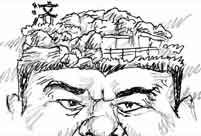 Unrest continues in Egypt
Unrest continues in Egypt
 Some parts of Shenyang waterlogged due to downpour
Some parts of Shenyang waterlogged due to downpour
 2013 Guangdong Fashion Week kicks off
2013 Guangdong Fashion Week kicks off
 Indian-controlled Kashmir celebrates Independence Day
Indian-controlled Kashmir celebrates Independence Day
 Left-behind kids' childhood on the side of country road
Left-behind kids' childhood on the side of country road
 Asian Youth Games opens in Nanjing
Asian Youth Games opens in Nanjing
 How do North Koreans stay cool in summer?
How do North Koreans stay cool in summer?
 China Beijing Int'l Gifts, Premium&Houseware Exhibition opens
China Beijing Int'l Gifts, Premium&Houseware Exhibition opens
 Incredible gardens around the world
Incredible gardens around the world
Monitoring carbon dioxide and humidity in the world heritage-listed Mogao Grottoes has been introduced to better protect the caves, experts with Dunhuang Academy said.
The grottoes, known for their Buddhist statues and frescoes, are near the oasis city of Dunhuang in southwest China's Gansu Province, a key stop-off point along the ancient Silk Road.
Thousands of visitors swarm every day to Mogao, the home to more than 2,000 colored sculptures and 45,000 square meters of frescoes in 735 caves carved along a cliff by ancient worshippers.
But it is not unusual that tourists are prevented from entering a certain cave as a sign in front of the locked door reads, "Temporarily closed due to carbon dioxide exceeding the standard."
A monitoring center was set up in June to monitor 24 pieces of different data in each cave including carbon dioxide concentration, humidity and visitor flow. The system issues a warning if any of the data exceeds the standard.
"We have used wireless sensor networks and other digital technologies to help analyze the correlation between environmental data in the caves and the extent of cultural relic erosion, to preserve the murals and sculptures in a more scientific way," said Wu Fatian, an academy researcher.
Experiments showed that glutenite, the supporting material for the murals, becomes active if humidity in a cave surpasses 62 percent. The murals might then become fragile and even fall off, said Fan Jinshi, the head of Dunhuang Academy.
"Of the 735 caves found in Mogao Grottoes, only 40 of them with an area of 50 to 100 square meters are opened to visitors. Most of the caves have an area smaller than 25 square meters. The vapor and carbon dioxide people exhale causes erosion and other damage to the murals and sculptures in such a limited area," said Fan.
More than 5,000 tourists have visited the grottoes each day since July. During the seven-day national day holiday in 2012, the daily number of tourists topped 18,000. However, academy experts said an acceptable number should only be about 3,000.
Carbon dioxide will not only damage historical relics but affect people's health.
"Once an interpreter passed out due to the high concentration of carbon dioxide in one of the caves," Fan said.
To ensure visitor safety and protect the cultural relics, the visiting route will be altered according to data collected.
The grottoes were listed in 1987 by the United Nations' Educational, Scientific, and Cultural Organization as a world heritage site.
 China, Russia vow to strengthen strategic ties
China, Russia vow to strengthen strategic ties Rooftop villa escalates public anger over bent rules
Rooftop villa escalates public anger over bent rules Beyond the blue and cool in China
Beyond the blue and cool in China Morsi supporters demonstrate near Egyptian embassy in Yemen
Morsi supporters demonstrate near Egyptian embassy in Yemen Beijing Int'l Gifts, Premium & Houseware Exhibition opens
Beijing Int'l Gifts, Premium & Houseware Exhibition opens Weekly Sports Photos: A 'Bolt' of lightning flashes across the sky
Weekly Sports Photos: A 'Bolt' of lightning flashes across the sky Escort taskforce holds anti-hijacking drill
Escort taskforce holds anti-hijacking drill Egypt's clashes kill 525 so far
Egypt's clashes kill 525 so far Sex offenders prey on left-behind kids
Sex offenders prey on left-behind kids Jaguar Land Rover to recall 11,852 cars
Jaguar Land Rover to recall 11,852 cars Ballet Swan Lake rehearsed in Taipei
Ballet Swan Lake rehearsed in Taipei  The five Hutong areas of Beijing
The five Hutong areas of BeijingDay|Week|Month